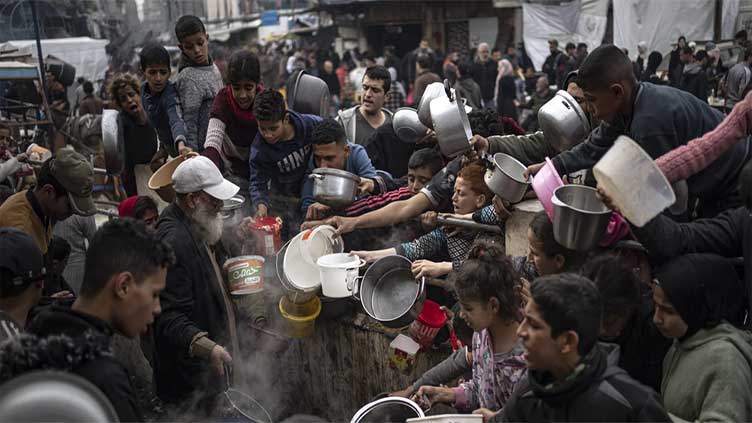Hunger experts say the risk of famine in Gaza remains high

World
Hunger experts say the risk of famine in Gaza remains high
NEW YORK (AP ) - The Gaza Strip is still at risk of famine more than a year into the Israel-Hamas war, even as the number of people facing the most extreme level of hunger has declined in recent months, the international authority on hunger crises said Thursday.
The findings come after the United States warned Israel that it might cut off military aid if its ally does not do more to address the humanitarian crisis in Gaza. Hundreds of thousands of people there are displaced from their homes and packed into squalid tent camps and schools-turned-shelters.
In recent weeks Israel has once again ordered the evacuation of the northern third of Gaza, and it launched another major military operation there. It allowed no food to enter the north for roughly the first two weeks of October before resuming shipments Monday.
According to the military’s own figures, a little over 5,800 tons of food have entered all of Gaza so far this month, compared with nearly 76,000 in September, and not all of those shipments have reached people inside. More than 500 trucks remain trapped on the Gaza side of the border, where the U.N. says it has difficulty retrieving the cargo because of Israeli military operations, lawlessness and other obstacles.
In a statement announcing a second shipment on Wednesday, the military said it will continue to act in accordance with international law “to facilitate and ease the entry of humanitarian aid to the Gaza Strip.”
The latest findings on hunger in Gaza were released by the Integrated Food Security Phase Classification, or IPC, an initiative set up in 2004 during the famine in Somalia that involves more than a dozen U.N. agencies, aid organizations, governments and other groups. It has repeatedly warned of famine over the course of the yearlong war, which was triggered by Hamas’ Oct. 7, 2023, attack into southern Israel.
Over 1.8 million people, or around 86% of Gaza’s population, are experiencing crisis levels of hunger, defined as Phase 3 or higher on the IPC’s five-point scale. Some 133,000 people, or around 6%, are at Phase 5, the highest level, known as catastrophic hunger. That is down from earlier periods of the war, when nearly a third of the population was at Phase 5.
The IPC warned the situation could rapidly deteriorate, and that it expects catastrophic hunger levels to double in the coming months. It cited a slowdown in aid in recent weeks, the onset of what is typically a cold and rainy winter, and the harsh conditions people face in crowded tent camps with little in the way of food, clean water or toilets.
Israel has controlled Gaza’s entire land border since May. The Israeli military body in charge of civilian affairs, known as COGAT, says it places no limits on humanitarian aid entering the territory and accuses U.N. agencies and aid groups of failing to promptly deliver it.
Those groups say their efforts are severely hampered by Israeli restrictions, ongoing fighting and displacement, and the breakdown of law and order in many areas.
At a public kitchen in central Gaza on Thursday, crowds of women and children lined up with empty pots to receive a thin tomato soup with peas and noodles.
“It’s been two weeks since we had enough food for ourselves and our children. A lot of food items disappeared from the markets because the crossings are closed,” said Mohammed Abed, who was displaced from Gaza City, in the northern part of the territory.
“We used to live a decent life, but now as you can see, we stand at kitchens to get a plate of food and bread,” said Aisha Saliby, who was also displaced from Gaza City. “End the war and let us go back home safely.”
U.N. Secretary-General Antonio Guterres said Thursday that he’s alarmed by the latest report, calling it “intolerable,” according to his spokesman.
Guterres demanded the immediate opening of crossing points and the removal of obstacles so U.N. agencies can deliver aid, said Farhan Haq, the spokesman.
Israel allowed no food to enter northern Gaza for the first two weeks of October, according to the U.N.'s World Food Program, as it waged a major military operation there that is still ongoing. U.N. humanitarian officials said last week that aid entering Gaza is at its lowest level in months.
Most residents of northern Gaza fled after evacuation warnings at the start of the war, and Israel has not allowed them to return. An estimated 400,000 people have remained there despite the harsh conditions. Palestinians say nowhere in the besieged territory feels safe.
Many fear Israel will implement a surrender-or-starve plan proposed by former generals calling for a cutoff in aid, and for anyone who ignores evacuation orders to be classified as a militant. The Israeli government has not said whether it has adopted the plan, which rights groups say would violate international law.
n a letter over the weekend, U.S. Secretary of State Antony Blinken and Defense Secretary Lloyd Austin warned Israel that if it did not increase the amount of humanitarian aid allowed into Gaza within the next 30 days it could risk losing U.S. weapons supplies for the ongoing wars against Hamas in Gaza and Hezbollah in Lebanon.
Israel has so far allowed two shipments into northern Gaza this week — a total of 80 trucks — and it says around 430 trucks have entered through the southern Kerem Shalom Crossing since the start of the month. That is far below the 350 trucks a day that the U.S. said were needed.
The United States has spent nearly $18 billion on military aid to Israel since the war in Gaza began, according to a report for Brown University’s Costs of War project.



